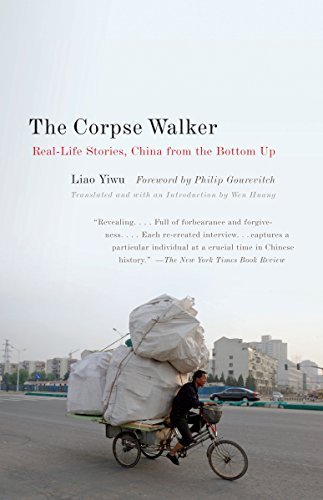What do you think?
Rate this book


Paperback
First published April 3, 2003
When a traveling businessman died of a sudden illness or accident, it was hard to transport the body back to his village to be buried in his native soil. And if a dead person is not returned to his hometown, as custom dictates, he would be called a lonely soul and a homeless ghost. So, since buses or trucks weren't available, if the family could afford it, they hired professional corpse walkers.
…one dark and overcast afternoon I was strolling along the village road when a bulky, black object suddenly passed me, sending a chill down my spine. The thing was covered with a huge inky-colored robe. The bottom hem of the robe was splattered with mud, and from time to time a leather shoe poked out below. The footsteps were heavy and made a repetitive, thudding noise, like someone knocking the ground with a block of wood. Just then, my friend Piggy scurried up to me and whispered in my ear: That's a corpse.
Piggy's words spooked me, and I ran around in front of the robe. A man was there, walking a few paces ahead of the corpse, wearing a beige vest and carrying a basket filled with fake paper money. In his other hand, he held a white paper lantern. Every few minutes, he would reach into the basket, grab some money, and toss it high in the air. You know the ritual, don't you? It's called “buying your way into the other world.” People in the countryside still believe that the fake money is used to bribe the corpse's guardian ghosts so they don't block the road to heaven.
Inside the black robe, there are two bodies: the corpse and a living person who carries the dead one on his back. During the trip, the person who carries the corpse has to use two hands to secure the body so it doesn't slide off. As you probably know, the body of a dead person becomes as stiff and as heavy as a stone. It takes eight people to carry a coffin. Imagine how tough it would be for one person, wrapped up in a large black robe, to walk hundreds of miles with a dead body on his back. Since it is hard for him to bend his knees, each move must be very stiff and awkward. On top of that, the black robe prevents him from being able to see what is ahead of him. Remember the white lantern that we talked about earlier? The light from the lantern is used to guide the corpse carrier.
LIAO: What was your first experience like?
QIAN: I couldn't sell anybody, so I married two of my daughters to two guys in a village in Gansu Province. My in-laws were considered relatively rich in the area. I received six hundred yuan and eight sheep. I sold the sheep to a peasant at the train station for fifty yuan each. So I ended up getting a thousand yuan [about $120]. I had never felt so rich. I was exhilarated beyond control. But a couple of days later, my daughters told me that they had met a few other Sichuan wives in the village. Those women were brought to the village by human traffickers, and guess the price those bastards asked for each woman: over two thousand yuan each. Basically, I lost money in the deal. Damn.
LIAO: Allow me to be frank with you. According to the court document, you had reenacted an ancient story mentioned in the Records of the Grand Historian, written by the famous historian Sima Qian. Based on the tale in the Records of the Grand Historian, Chen Sheng, a peasant rebel in the Qin dynasty [221 bc–206 bc], attempted to rally public support against the emperor and justify his claim to the throne by inserting a yellow ribbon inside a fish. Then, the cook “accidentally” discovered the fish and the ribbon, which said “King Chen Sheng.” Everyone believed it was a message from the Heavenly God and they all joined Chen's uprising, which eventually led to the downfall of the Qin dynasty. Apparently, Ma Xing reenacted every detail.